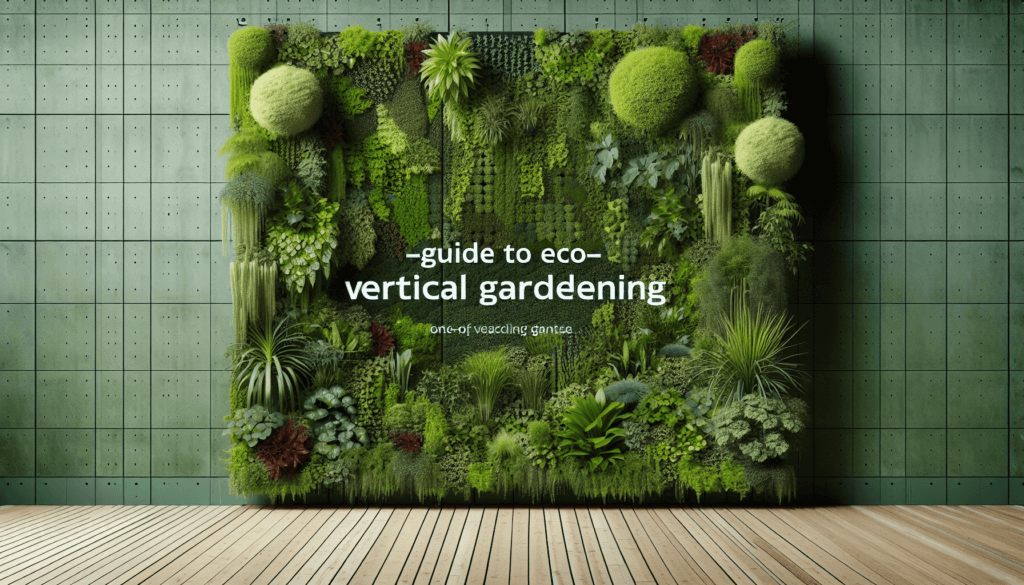Are you looking to create a sustainable and picturesque garden in your limited outdoor space? Look no further than the Guide to Eco-Friendly Vertical Gardening. In this comprehensive guide, you will discover innovative methods to maximize your gardening potential through vertical structures. From hanging baskets to living walls, we will explore how to cultivate a vibrant and thriving garden while conserving space, resources, and promoting eco-consciousness. Transform your backyard or balcony into a green oasis and embrace the beauty and benefits of vertical gardening.
1. Benefits of Vertical Gardening
Utilizes limited space
Vertical gardening is an excellent solution for individuals who are short on space but still want to enjoy the benefits of having a garden. With vertical gardening, you can maximize the use of limited space by growing plants upwards, making use of walls, fences, and other vertical structures. This allows you to create a beautiful garden even in compact urban areas or small balconies.
Improves air quality
One of the significant advantages of vertical gardening is its positive impact on air quality. Plants have the remarkable ability to absorb harmful pollutants and release oxygen, thus purifying the air we breathe. By incorporating vertical gardens into your living spaces, you can significantly improve the air quality around you, creating a healthier and more pleasant environment for yourself and your loved ones.
Reduces energy consumption
Vertical gardening also helps in reducing energy consumption. By covering walls or structures with plants, you can create a natural barrier that provides insulation, effectively reducing the need for air conditioning during hot summer months. This decreases energy costs and promotes a more sustainable lifestyle. Additionally, the shade provided by vertical gardens can help lower the temperature in your immediate surroundings, making your outdoor space more comfortable.
Enhances biodiversity
Vertical gardens play a vital role in enhancing biodiversity in urban areas. By providing a habitat for birds, bees, butterflies, and other beneficial insects, vertical gardens help support the local ecosystem. The presence of these pollinators also promotes the growth and reproduction of plants, ensuring a thriving and diverse garden. In this way, vertical gardening can contribute to the preservation of biodiversity even in highly urbanized environments.
Provides food security
Lastly, vertical gardening offers the advantage of food security. By growing your own fruits, vegetables, and herbs, you can ensure a constant supply of fresh and nutritious produce right at your doorstep. This self-sufficiency not only allows you to control the quality of the food you consume but also reduces your reliance on external sources. Vertical gardening empowers you to take charge of your own food production and promotes a sustainable and resilient lifestyle.
2. Choosing the Right Location for Your Vertical Garden
Consider sunlight exposure
When selecting the location for your vertical garden, it is crucial to consider the amount of sunlight the area receives. Most plants require a minimum of six hours of direct sunlight per day to thrive. Observe the area throughout the day and note how the sunlight moves across the space. Choose a location that receives adequate sunlight, whether it be on a wall facing south or a spot with unobstructed access to sunlight.
Evaluate wind conditions
Wind can have a significant impact on the health and stability of your vertical garden. Strong winds can damage plants and cause them to topple over, especially if they are not properly secured. Evaluate the wind conditions in your chosen location to determine if it is suitable for vertical gardening. If the area experiences strong gusts of wind, you may need to install windbreaks or choose sturdier plants that can withstand such conditions.
Assess water accessibility
Water is a crucial element for the success of any garden, including vertical gardens. Before setting up your vertical garden, assess the water accessibility in your chosen location. Ensure that there is a convenient water source nearby, whether it is a tap, a rainwater collection system, or a hose. Adequate water availability is essential for regular watering and proper hydration of your plants.
Check structural integrity
Before installing a vertical garden, it is essential to check the structural integrity of the chosen wall or structure. Vertical gardens can be heavy, especially when fully grown and watered. Make sure the wall or structure can handle the weight of the plants, soil, and additional accessories. Consult with a professional if necessary to ensure the safety and stability of your vertical garden.
Ensure proper drainage
Proper drainage is another critical factor to consider when choosing the location for your vertical garden. Excess water must be able to drain out effectively to prevent waterlogging, which can lead to root rot and other plant diseases. Evaluate the existing drainage system or make provisions for suitable drainage in your vertical garden setup. Creating sufficient drainage holes in plant containers or using permeable materials for your vertical garden frame can help ensure proper water drainage.

3. Materials and Tools for Vertical Gardening
Vertical garden frames
Vertical garden frames provide the structure and framework for your vertical garden. These frames can be made from various materials, such as wood, metal, or plastic. Choose a frame that suits your aesthetic preferences and durability requirements. Some popular options include freestanding trellises, wall-mounted frames, and modular systems that allow for customization and easy expansion.
Soil and compost
Selecting the right soil and compost is crucial for the health and growth of your plants. Use a high-quality planting mix that is well-draining and nutrient-rich. Potting soil mixes specifically formulated for vertical gardening are available and can be an excellent choice. Additionally, adding compost to your soil can enrich it with essential nutrients, improve moisture retention, and promote healthy plant growth.
Suitable plant containers
Choosing the right plant containers is essential for vertical gardening success. Consider the size, material, and drainage capabilities of the containers. You can use traditional plant pots, hanging baskets, or even repurpose containers such as plastic bottles or wooden crates. Ensure that the containers are securely attached to the vertical garden frame and provide enough space for the plants’ root systems to grow.
Watering systems
Efficient watering is crucial for the health and survival of your vertical garden. Consider using a watering system that suits your needs and preferences. Options include drip irrigation systems, which deliver water directly to the plant roots, and micro-sprinklers, which provide a gentle misting effect. Self-watering systems and wicking systems are also popular choices, as they provide consistent moisture to the plants without excessive water wastage.
Vertical garden accessories
To add a touch of creativity and functionality to your vertical garden, consider using accessories such as trellises, hooks, and hanging baskets. These accessories can help support climbing plants, allow for vertical plant arrangements, and provide additional storage space. Your choice of accessories will depend on your desired aesthetic, the types of plants you are growing, and the available space in your vertical garden.
4. Selecting Plants for Vertical Gardening
Choose space-saving plants
When selecting plants for vertical gardening, opt for varieties that are known for their compact growth or vertical habit. These plants take up less space horizontally and are well-suited for vertical arrangements. Examples of space-saving plants include lettuce, spinach, strawberries, and radishes. Additionally, consider using vining plants that can climb vertical structures, such as tomatoes, cucumbers, and beans. This way, you can maximize your vertical garden’s productivity without sacrificing valuable space.
Consider light requirements
Different plants have varying light requirements, ranging from full sun to partial shade. When choosing plants for your vertical garden, consider the amount of sunlight the location receives and match it with the plants’ light requirements. This ensures that your plants receive optimal light for healthy growth and prevents issues such as sunburn or leggy growth.
Evaluate water needs
Plants also have different water requirements, and it is essential to consider these needs when selecting plants for vertical gardening. Some plants thrive in consistently moist soil, while others prefer drier conditions. Group plants with similar water needs together to simplify your watering routine and ensure that each plant receives the appropriate amount of water.
Select plants with shallow roots
Vertical gardens often have limited soil depth, so selecting plants with shallow root systems is beneficial to their overall health and growth. Plants with shallow roots can easily adapt to the confined space and receive the necessary nutrients and moisture. Examples of plants with shallow roots include lettuce, herbs, and many flowering annuals.
Consider edible options
If you are interested in growing your own food, vertical gardening offers an excellent opportunity to incorporate edible plants into your garden. Herbs, lettuce, peppers, tomatoes, and strawberries are just a few examples of edible plants that can thrive in a vertical garden. Growing your own food not only provides you with fresh and flavorful ingredients but also reduces your carbon footprint by decreasing the need for transportation and packaging.

5. Preparing the Vertical Garden
Install the vertical garden frame
Once you have chosen the right location, it’s time to install the vertical garden frame. Follow the manufacturer’s instructions or consult a professional if needed to ensure proper installation. Make sure the frame is securely attached to the wall or structure and can support the weight of the plants and soil.
Prepare the soil or compost
Before planting, prepare the soil or compost to ensure it is ready to support the plants’ growth. Amend the soil with organic matter such as compost or well-rotted manure to enhance its fertility and drainage. If using a planting mix, ensure that it is moistened before filling the plant containers.
Position the plant containers
Carefully position the plant containers on the vertical garden frame, ensuring that they are securely fastened and evenly spaced. Consider the growth habits and space requirements of your chosen plants to allow enough room for their development.
Set up the watering system
Install your chosen watering system to ensure consistent and efficient watering of your plants. Follow the manufacturer’s instructions to correctly set up the system and make any necessary adjustments. Test the system to ensure it is functioning properly before moving on to the next steps.
Include support structures
If growing climbing plants such as tomatoes or beans, install support structures such as trellises or netting to guide their upward growth. These structures provide stability and prevent the plants from toppling over. Ensure that the support structures are sturdy and properly anchored to the vertical garden frame.
6. Maintaining Your Vertical Garden
Monitor sunlight and water levels
Regularly monitor the sunlight exposure and water levels in your vertical garden. Observe how the plant leaves respond to the available light and adjust the location or shade accordingly. Check the soil moisture regularly, especially during hot and dry periods, and water as needed. Avoid overwatering, as it can lead to root rot and other issues.
Prune and trim regularly
To maintain your vertical garden’s neat appearance and promote healthy growth, prune and trim your plants regularly. Remove any dead or wilted leaves, spent flowers, or diseased parts. Pruning also helps shape the plants and improves airflow, reducing the risk of fungal diseases. Use clean and sharp pruning tools to avoid causing damage to the plants.
Protect against pests and diseases
Keep an eye out for pests and diseases that may affect your plants. Inspect the leaves, stems, and soil regularly, looking for signs of infestation or disease. If you notice any issues, take appropriate measures such as using organic pest control methods or removing affected plants to prevent the spread of pests or diseases.
Fertilize appropriately
Regularly fertilize your vertical garden to ensure the plants receive the necessary nutrients for healthy growth. Choose organic fertilizers that are suitable for your plants’ specific needs and follow the recommended dosage instructions. Avoid over-fertilization, as it can result in nutrient imbalances and environmental pollution.
Harvest and replant as needed
Enjoy the fruits of your labor by harvesting your crops when they are ripe and ready. Regularly harvest herbs and vegetables to promote continuous growth and ensure optimal flavor and quality. Additionally, replant any empty containers as needed to maintain the productivity and aesthetics of your vertical garden.

7. Irrigation Techniques for Vertical Gardens
Drip irrigation
Drip irrigation is a popular and efficient technique for watering vertical gardens. It delivers water directly to the plant roots, minimizing water wastage and reducing the risk of leaf diseases. Drip irrigation systems consist of tubes with small emitters that release water at a slow and steady rate. This method ensures that each plant receives the required amount of water without excessive runoff or evaporation.
Micro-sprinklers
Micro-sprinklers are another irrigation option for vertical gardens. These small sprinklers release a fine mist or spray that covers a larger area than drip emitters. Micro-sprinklers can provide a cooling effect in hot weather and help maintain appropriate humidity levels. However, they may require a higher water supply and need careful placement to avoid wasting water or wetting areas that don’t need irrigation.
Wicking systems
Wicking systems are self-watering systems that can be used in vertical gardens. These systems rely on capillary action, drawing water from a reservoir and delivering it to the plants’ root zone. Wicking systems are easy to set up and can provide a consistent water supply, making them ideal for areas with limited access to water sources.
Hydroponics
Hydroponics is a soilless growing technique that can be adapted for vertical gardening. In hydroponics, plants are grown in a nutrient-rich solution instead of soil. This method maximizes water efficiency and allows for precise control over nutrient delivery. Vertical hydroponic systems can be designed to fit the specific needs of your plants and can promote rapid growth and high yields.
Rainwater harvesting
Harvesting rainwater is an excellent sustainable practice for vertical gardening. By collecting rainwater, you can reduce your dependence on municipal water supplies and conserve freshwater resources. Install rain barrels or larger water storage tanks to capture and store rainwater from roofs or gutters. Use this stored rainwater for your irrigation needs, ensuring it is properly filtered and free from contaminants.
8. Vertical Garden Design Ideas
Herb and vegetable walls
Create an edible vertical garden by dedicating a section of your wall to growing herbs and vegetables. Choose compact varieties and arrange them in an aesthetically pleasing pattern. This design idea allows you to easily access fresh herbs and vegetables for cooking while saving space in your outdoor or indoor areas.
Flower-filled trellises
Embrace the beauty of flowers by incorporating flower-filled trellises into your vertical garden design. Select climbers such as morning glories, sweet peas, or clematis, and train them to grow on trellises or other vertical structures. The result is a stunning display of colors and blooms that adds visual interest to any space.
Living walls with succulents
For a low-maintenance and water-wise vertical garden, consider creating living walls with succulents. Succulents are known for their ability to thrive in dry conditions, making them perfect for vertical gardening. Choose a variety of succulent species with different textures and colors to create an eye-catching and drought-tolerant living wall.
Vertical herbal gardens
If you have a passion for herbs, dedicate your vertical garden entirely to growing a variety of aromatic plants. Use vertical garden frames with multiple levels or pocket planters to accommodate different herbs. Label the herbs to make identification easier and enjoy the convenience of having fresh herbs at your fingertips, whether it’s for cooking, tea, or natural remedies.
Floating vertical gardens
For a unique and visually striking vertical garden, explore the concept of floating gardens. These gardens can be created using repurposed materials such as pallets or floating shelves, allowing plants to seemingly float in mid-air. Arrange a variety of trailing plants, ferns, or air plants on the floating structures to create a mesmerizing and one-of-a-kind vertical garden.

9. Troubleshooting Common Vertical Gardening Issues
Inadequate sunlight
If your vertical garden is not receiving enough sunlight, consider relocating it to a sunnier spot or adjusting the position of the plants by using hooks or adjustable hanging mechanisms. Additionally, choose shade-tolerant plants that can thrive in lower light conditions, such as ferns or certain herbs.
Poor drainage
Poor drainage in a vertical garden can lead to waterlogging, which can result in root rot and other plant diseases. To improve drainage, ensure that your containers have drainage holes and use a well-draining soil mix. Consider using permeable materials for your vertical garden frame to allow excess water to escape freely.
Overwatering or underwatering
Maintaining the right moisture balance is crucial for plant health in a vertical garden. Overwatering can suffocate roots, while underwatering can cause plants to wilt and become stressed. Water your plants thoroughly when the soil feels dry to the touch and avoid overwatering by allowing excess water to drain out. Consider installing a moisture sensor or using a finger test to help monitor soil moisture levels accurately.
Pests and diseases
Like any garden, vertical gardens can be susceptible to pests and diseases. Inspect your plants regularly for signs of pests such as aphids, mealybugs, or spider mites. Use organic pest control methods such as neem oil or insecticidal soap to manage infestations. Additionally, practice good garden hygiene by removing dead plant material and maintaining proper airflow to prevent the spread of diseases.
Nutrient deficiencies
Vertical gardens may experience nutrient deficiencies, especially if soil quality is poor or if plants are not provided with adequate fertilization. Monitor your plants for signs of nutrient deficiencies such as yellowing leaves or stunted growth. Address nutrient deficiencies by using organic fertilizers or applying compost to enrich the soil. Regularly testing the soil to determine nutrient levels can also help ensure optimal plant health.
10. Sustainable Practices for Vertical Gardening
Using organic fertilizers
Opt for organic fertilizers to promote sustainability in your vertical garden. Organic fertilizers are derived from natural sources and are less likely to cause harm to the environment or leach chemicals into the soil. Examples of organic fertilizers include compost, worm castings, and seaweed extract. Use these eco-friendly options to provide your plants with the nutrients they need while minimizing environmental impact.
Composting kitchen scraps
Reduce waste and create nutrient-rich compost by composting your kitchen scraps. Set up a compost bin or vermicomposting system to transform vegetable peels, coffee grounds, and other organic waste into valuable compost. Use this compost to enrich the soil in your vertical garden, closing the nutrient cycle and reducing the need for external inputs.
Conserving water
Water conservation is crucial for sustainable vertical gardening. Implement water-saving practices such as mulching the soil surface to reduce evaporation, utilizing efficient irrigation systems, and collecting rainwater for irrigation purposes. Additionally, group together plants with similar water needs to avoid overwatering or underwatering, thereby conserving water and promoting the health of your plants.
Repurposing materials
Embrace the ethos of sustainability by repurposing materials for your vertical garden. Get creative with repurposed containers such as old buckets, jars, or cans as plant pots. Use reclaimed wood or pallets to construct your vertical garden frame. By repurposing materials, you reduce waste and give new life to items that would otherwise end up in a landfill.
Encouraging beneficial insects
Attracting beneficial insects to your vertical garden can help control pests naturally and contribute to the overall health of your garden ecosystem. Planting flowers that attract pollinators, such as lavender or cosmos, can provide a food source for beneficial insects. Additionally, consider creating insect-friendly habitats, such as installing bee houses or leaving areas of bare soil for ground-dwelling beneficial insects to inhabit.
In conclusion, vertical gardening offers numerous benefits, including space utilization, improved air quality, reduced energy consumption, enhanced biodiversity, and food security. By selecting the right location, using suitable materials and tools, and choosing appropriate plants, you can create a vibrant and eco-friendly vertical garden. With proper maintenance, including monitoring sunlight and water levels, regular pruning and pest control, and sustainable practices, your vertical garden will flourish and provide a beautiful and sustainable oasis. So, roll up your sleeves, grab your gardening tools, and embark on your vertical gardening journey today!



